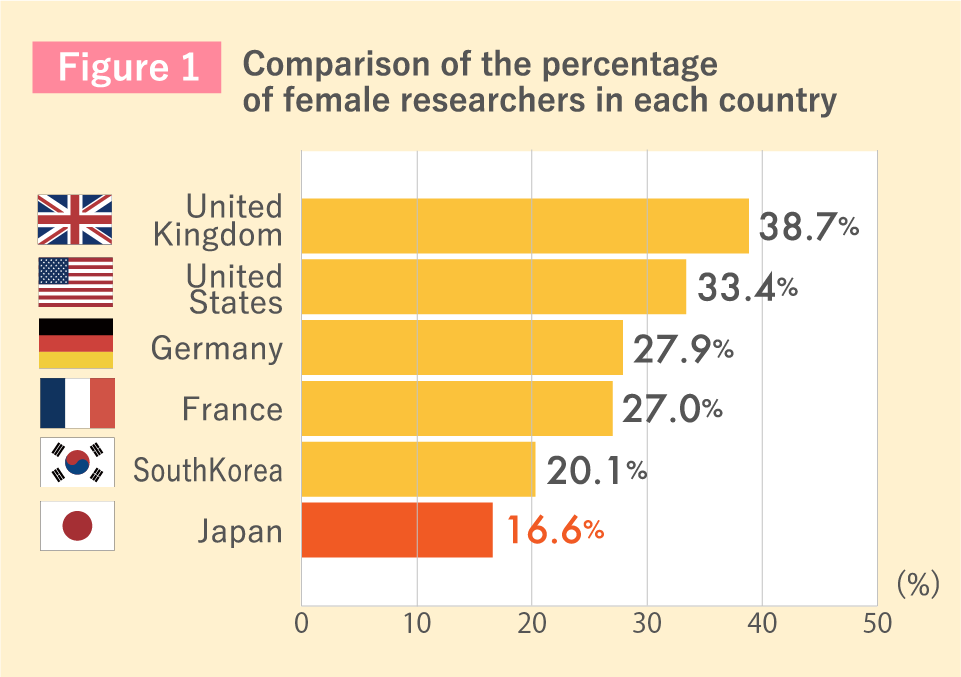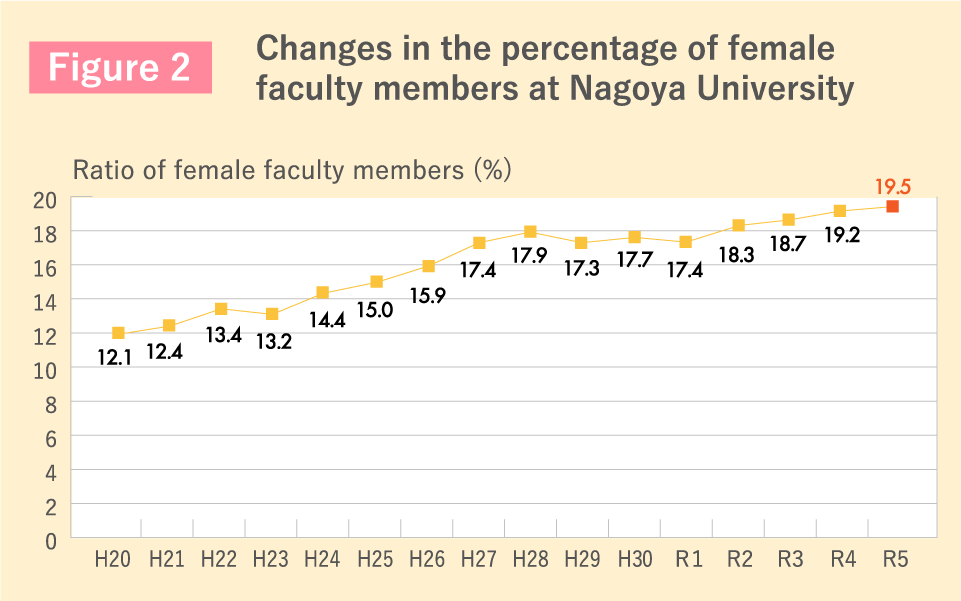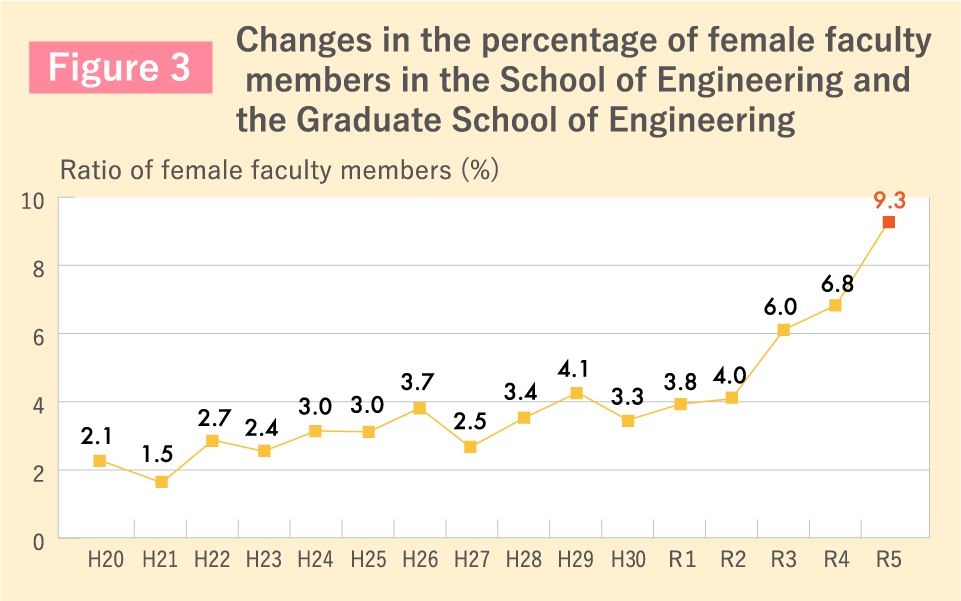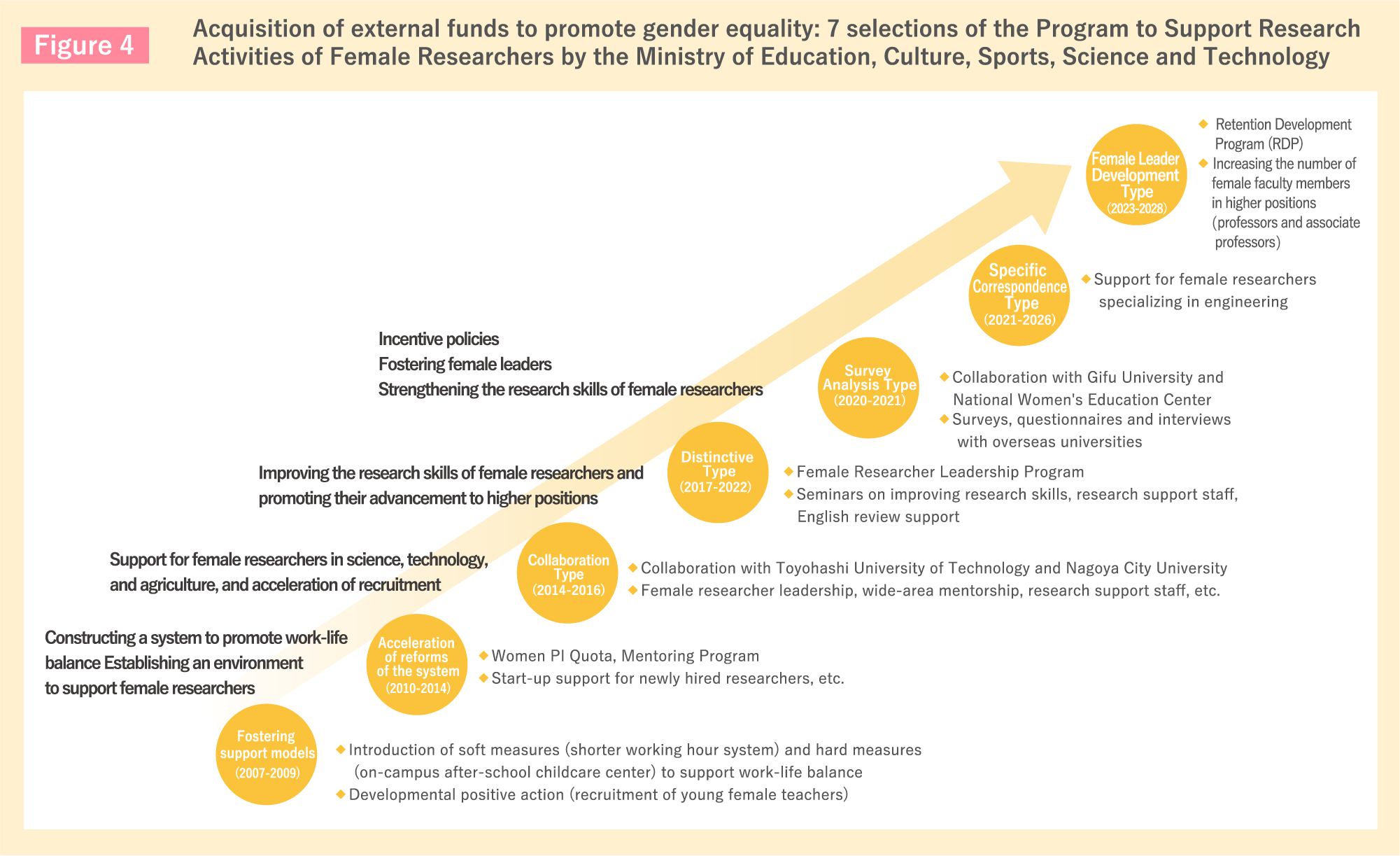Support for Female Researchers at Nagoya UniversityEmpowering female researchers to
open the door to the future
The Program to Support Research Activities of Female Researchers
by the Ministry of Education, Culture, Sports, Science and Technology
The Ministry of Education, Culture, Sports, Science and Technology (MEXT) launched programs to support female researchers in fiscal year 2006 to promote the activities of female researchers.
As shown in Figure 1, the reason for these programs was the extremely low percentage of female researchers in Japan compared to other advanced countries in Europe and the United States, and the lack of progress in promoting women to higher positions. The promotion of female researchers is important not only from the perspective of gender equality, but also for stimulating research activities and demonstrating the creative power of the organization.
This program, which aims to broaden the base of female researchers, supports universities and other institutions that promote the balancing of research with life events such as childbirth, child rearing, and nursing care, as well as the improvement of the research skills of female researchers in an integrated manner so that they can demonstrate their abilities to the fullest.
In fiscal year 2015, MEXT launched the new Initiative for Realizing Diversity in the Research Environment.

Source:FY 2019 MIC Japan ”Report on the survey of research and development”
OECD ”Main Science and TechnologyIndicators”
NSF ”Science and Engineering Indicators 2018”
Running a wide variety of projects to enhance support!
Projects adopted for the Program to Support Research Activities of Female Researchers by the Ministry of Education, Culture, Sports, Science and Technology
Nagoya University has been one of the first universities to engage in a variety of projects to foster female researchers.
From fiscal year 2007 to the present, our seven projects have been selected for MEXT Program to Support Research Activities of Female Researchers including the Initiative for Realizing Diversity in the Research Environment (Specific Correspondence Type) and we have been vigorously developing our efforts.
As part of the Developmental Female Researcher Support Model at Nagoya University project, which was adopted in fiscal year 2007 as a project for fostering support models for female researchers, we established a permanent on-campus after-school childcare center ahead of other offices nationwide. We enhanced our work-life balance (WLB) environment in terms of both hard and soft measures, such as shorter working hours while raising children, to help researchers balance research with childcare and family. In conjunction with this, we also implemented a developmental positive action project to develop the potential of young female researchers. Points were assigned for the hiring and promotion of female faculty members, and the department with the highest number of points over a three-year period was given support for personnel or research expenses for specially appointed female faculty members, with the aim of accelerating the hiring of young female faculty members by transferring them to tenured faculty without a fixed term after three years.
Under the Employment Acceleration and Career Development Program for Women Researchers: The Nagoya University Model, adopted in fiscal year 2010 to accelerate the reforms of the female researcher training system, a total of 29 female faculty members in science, technology and agriculture were hired over a five-year period. We focused on hiring women in high-ranking positions and established the Women PI Quota (open recruitment of female professors and associate professors to lead research in science, technology, and agriculture). In addition, a Mentoring Program was conducted in collaboration with the Center for the Studies of Higher Education.
The AICHI Consortium for Supporting Female Researchers, launched with Nagoya City University and Toyohashi University of Technology, is a project adopted in fiscal year 2014 for the Program to Support Research Activities of Female Researchers (Collaboration Type). A unique feature of this project is its commitment to supporting the programs to support the research activities of female researchers by industry, academia, and government in Aichi Prefecture. With the objectives of improving the research capabilities of female researchers and promoting them to higher positions, we implemented the Female Researcher Leadership Program, the Toyota Female Researcher Internship Program, the Wide-Area Mentorship Program, and more.
In the Initiative for Realizing Diversity in the Research Environment (Distinctive Type) (FY2017 to 2022), we worked on awarding of top female researcher leaders, focusing on visualization of top leaders and raising awareness within the university. In addition, we are implementing the Female Researcher Leadership Program, various seminars to improve research skills, and initiatives to support the promotion of work-life balance.
The Initiative for Realizing Diversity in the Research Environment (Survey Analysis Type) (FY2020 to 2021) involved conducting field surveys and questionnaires in a joint effort with Gifu University and the National Women’s Education Center on advanced examples of support for female researchers at overseas universities. Based on the survey results, we developed and released the Unconscious Bias Training Program in Universities and Faculty Recruitment Manual for Promoting Diversity in Universities.
The Initiative for Realizing Diversity in the Research Environment (Specific Correspondence Type), adopted in 2021, is designed to identify what is preventing female researchers from entering the field of engineering where the number of female researchers is remarkably low, and to create a research environment that can resolve specific issues.
In 2023, our new project was adopted for Initiative for Realizing Diversity in the Research Environment (Female Leader Development Type). We will develop the Retention Development Program (RDP), which comprehensively pursues the development of a research environment, improvement of research capabilities, leadership training, and promotion of women to higher positions, with the aim of increasing the number of female faculty members in higher positions (professors and associate professors) in particular.
As shown in Figures 2 and 3, we have achieved a certain level of success in both the ratio of female faculty members and engineering faculty members at Nagoya University, but we are still in the process of making improvements. We will continue to carry out a variety of projects to further foster female researchers.

Source: Nagoya University Profile 2008-2023 (as of May 1 of each fiscal year)

Source: Nagoya University Profile 2008-2023 (as of May 1 of each fiscal year)


